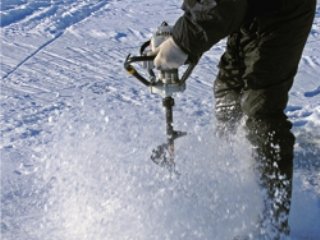 Many fishermen love to pull in their limits each winter through the ice, but without the proper equipment, the energy needed to endure hours of frigid winds and numbing ice will quickly deplete. Not only will spending precious time and energy toiling at ice fishing’s routine tasks without optimal gear make you tired and lethargic, but it will make packing up your tackle—not to mention, your catch—that much more daunting at the end of your trip. The first step in assuring that this doesn’t happen to you is making sure you grab the right style and right sized ice auger for your needs. You wouldn’t use the wrong tool while working on your car, would you? Then there’s no reason to use the wrong auger for the ice, and I’ll show you how to pick one that will get the job done.
Many fishermen love to pull in their limits each winter through the ice, but without the proper equipment, the energy needed to endure hours of frigid winds and numbing ice will quickly deplete. Not only will spending precious time and energy toiling at ice fishing’s routine tasks without optimal gear make you tired and lethargic, but it will make packing up your tackle—not to mention, your catch—that much more daunting at the end of your trip. The first step in assuring that this doesn’t happen to you is making sure you grab the right style and right sized ice auger for your needs. You wouldn’t use the wrong tool while working on your car, would you? Then there’s no reason to use the wrong auger for the ice, and I’ll show you how to pick one that will get the job done.
First and foremost, let’s take a look at the three basic types of augers: manual, gas, and electric. Manual augers are the most popular choice and appeal to everyone from the casual to the most experienced ice fisherman, due to their mobility and their ease of use. One advantage manual augers have over their gas counterparts is that they’re much quieter, which allows you to drill without scaring away fish. The Lazer and Mora models, made by Strikemaster, have been famous choices throughout the years, and are available at many retailers. The Lazers tend to be more expensive, but their sharper blades and more durable materials are worth the extra money, especially if you plan on using them more than once or twice. The only down side of using manual augers is that you will have to operate them yourself, though, this makes them ideal for those who don’t plan on drilling too many holes.
For those who are constantly moving around the lake or who encounter thicker ice, gas and electric augers are known for quickly and effortlessly drilling holes, which will save you both time and energy. Both styles make short work of thicker ice, which will have your arms and back thanking you at the end of the day. The disadvantages, however, are their increased weight and, like any piece of equipment, their need for constant maintenance and repairs.
One more important factor to consider when choosing an auger is the size of the blade, which really depends on the species you’re targeting. Each company offers several different sizes for their augers, which seems to open an entirely new can of worms for many consumers. Like I’ve told customers in the past, too much of something is, in my opinion, better than not enough, and you don’t want to be on the ice, fighting a large fish, only to find yourself wishing you had a bigger hole in the ice to pull it through. Obviously, if you’re targeting bluegill, you won’t need much, but if you plan on wrestling a pike or large trout, it may be worth it to grab a larger blade.
Choosing an ice auger isn’t much different than choosing any other major piece of tackle, such as a reel or rod. Just be sure to focus on what species you’ll go for, how often you’ll use it, and how thick the ice will be. Like any other tool, maintain proper care of your augers and use them properly, and you’ll find that they’ll continue to work for you throughout several years.








